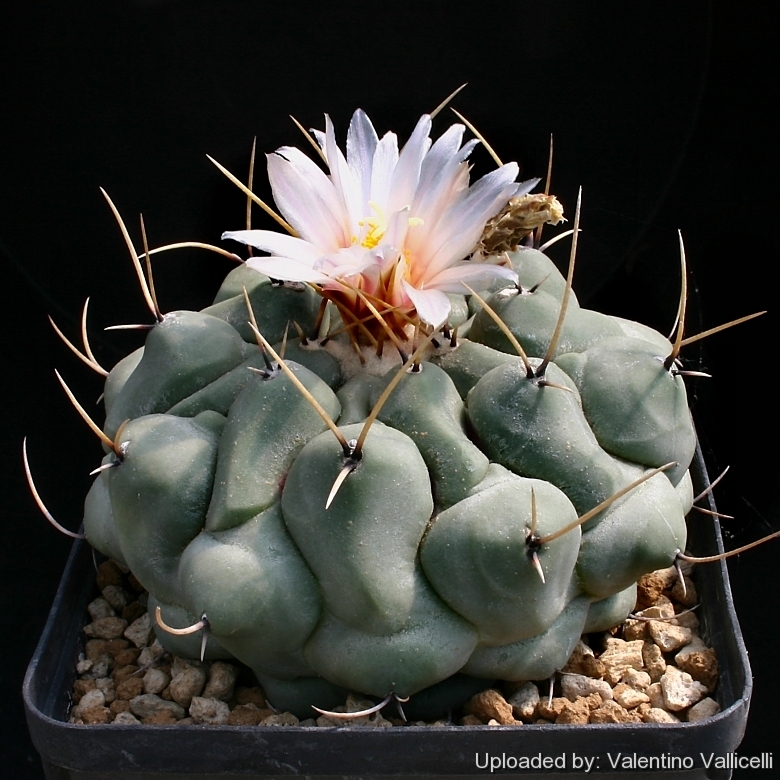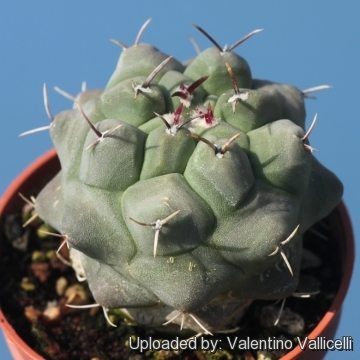= Thelocactus rinconensis subs. phymatothelos (Poselg.) Glass
Guía Identif. Cact. Amenazadas México 1: Th/rin ssp. hintonii (1998 publ. 1997), as 'phymatothele' Remarks: Doweld [Succulenty (Moscow) 1(2): 30. 1999] also made this comb. nov. isonym; Glass
Accepted Scientific Name: Thelocactus rinconensis (Poselg.) Britton & Rose
Cactaceae (Britton & Rose) 4: 7. 1923 [24 Dec 1923] Britton & Rose

Echinocactus phymatothelos (Thelocactus rinconensis subs. phymatothelos) Photo by: Valentino Vallicelli
It can be distinguished from other form of the Thelocactus rinconensis complex because the stem is always strongly depressed and glaucous , the spines are shorter and slightly curved, and the flowers are more or less clear pink.
Origin and Habitat: It is known only from the slopes of Arteaga Canyon just south of Saltillo, Coahuila. Mexico.
Altitude: Around 1900 metres above sea level.
Habitat: Chihuahuan Desert. Often found growing together with Neolloydia conoideaSN|10089]]SN|10089]].
Synonyms:
See all synonyms of Thelocactus rinconensis
Description: Thelocactus rinconensisSN|10887]]SN|10887]] subs. phymatothelos, better known as Thelocactus phymatothelos, can be distinguished from other forms of the Thelocactus rinconensis complex because the stem is always strongly depressed and glaucous, the spines are few, shorter and slightly curved, and the flowers are more or less clear pink.
Habit: Usually solitary or very slow to offset, develops a squat and highly ribbed stem with a flattened top.
Stem: Spherical with a compressed top, 9-15(-20) cm across, ap to 10 cm tall, chalky-grey, silvery-grey, glaucous sometimes tinged with purple.
Ribs: Mostly obscured by tubercles that are very prominent angled but more rounded and compressed than those of the main species Thelocactus rinconensisSN|10887]]SN|10887]]. Tubercles up to 1,5 cm hight.
Areoles: Round to elongate, mostly more than 2 cm apart and without nectaries.
Spines: Usually short but variable in length, depending on the clone, dark, usually black-brown , pale at apex, but also grey, brown or yellow, with a distinctive silvery appearance, and sometimes shredding. Spines in old age shiny grey-white.
Central spines: Most often 1-2 (rarely more) slightly curved, sometimes scaly with age, usually very short or occasionally up to 6 cm long.
Radial Spines: up to 5 (usually only1-2) similar to the centrals, erect to radiating, slightly curved shorter than the centrals.
Flowers: 3-5 cm long, 2,7-3 cm in diameter, white to pinkish with a pink midstripe. Tube short, pericarpels covered
with scales. The plants usually fail to flower until they are 5-9 years old.
Fruit: Spherical ta oblong with scales, 7-9 mm in diameter, greenish or yellowish, slightly fleshy when ripe, opening by basal pore.
Subspecies, varieties, forms and cultivars of plants belonging to the Thelocactus rinconensis group
 Thelocactus rinconensis (Poselg.) Britton & Rose: has a squat and highly ribbed, glaucous-grey, stem, sometimes tinged with purple. it is extremely variable in its spines. Distribution: Coahuila and Nuevo Leon.
Thelocactus rinconensis (Poselg.) Britton & Rose: has a squat and highly ribbed, glaucous-grey, stem, sometimes tinged with purple. it is extremely variable in its spines. Distribution: Coahuila and Nuevo Leon. Thelocactus rinconensis subs. freudenbergeri (R.Haas) Mosco & Zanov.: This subspecies differs from the type for the presence of acicular radial spines and the beautiful magenta flowers. Distribution: Nuevo León, near Grutas de Garcia.
Thelocactus rinconensis subs. freudenbergeri (R.Haas) Mosco & Zanov.: This subspecies differs from the type for the presence of acicular radial spines and the beautiful magenta flowers. Distribution: Nuevo León, near Grutas de Garcia. Thelocactus rinconensis var. lophothele hort.: vigorous plant solitary or sprouting at the base with ribs thickened at intervals into tubercles. Radial spines finer, central spines clearly different long. Distribution:Saltillo, Coahuila.
Thelocactus rinconensis var. lophothele hort.: vigorous plant solitary or sprouting at the base with ribs thickened at intervals into tubercles. Radial spines finer, central spines clearly different long. Distribution:Saltillo, Coahuila. Thelocactus rinconensis subs. nidulans (Quehl) Glass: has long spines so grouped and arranged that they look like a bird s nest. Distribution: Coahuila, particularly around Saltillo and Parras.
Thelocactus rinconensis subs. nidulans (Quehl) Glass: has long spines so grouped and arranged that they look like a bird s nest. Distribution: Coahuila, particularly around Saltillo and Parras. Thelocactus rinconensis subs. palomaensis Pavlíček & Zatloukal: stem up to 250 Ø silvery green. Ribs 13 , deeply divided into tubercle with blunt keel. Central spines 2-4, brownish up to 80 mm long, radials 4-11 yellowish and glassy. Distribution: Northern border of the Sierra Paila, Coahuila
Thelocactus rinconensis subs. palomaensis Pavlíček & Zatloukal: stem up to 250 Ø silvery green. Ribs 13 , deeply divided into tubercle with blunt keel. Central spines 2-4, brownish up to 80 mm long, radials 4-11 yellowish and glassy. Distribution: Northern border of the Sierra Paila, Coahuila Thelocactus rinconensis subs. phymatothelos (Poselg.) Glass: stem is always strongly depressed and glaucous, the spines are shorter and slightly curved, and the flowers are more or less clear pink. Distribution: Arteaga and Saltillo, Coahuila.
Thelocactus rinconensis subs. phymatothelos (Poselg.) Glass: stem is always strongly depressed and glaucous, the spines are shorter and slightly curved, and the flowers are more or less clear pink. Distribution: Arteaga and Saltillo, Coahuila.
Notes: Thelocactus phymatothelos is now considered a synonym of Thelocactus rinconensisSN|10899]]SN|10887]], along with Thelocactus lophotheleSN|10887]]SN|10899]], Thelocactus nidulans, and others. It is not sufficiently distinct to deserve its own formal status.
Bibliography: Major references and further lectures
1) Edward Anderson “The Cactus family” Timber Press, Incorporated, 2001
2) James Cullen, Sabina G. Knees, H. Suzanne Cubey "The European Garden Flora Flowering Plants: A Manual for the Identification of Plants Cultivated in Europe, Both Out-of-Doors and Under Glass" Cambridge University Press, 11/Aug/2011
3) David R Hunt; Nigel P Taylor; Graham Charles; International Cactaceae Systematics Group. "The New Cactus Lexicon" dh books, 2006
4) Urs Eggli, Leonard E. Newton: “Etymological Dictionary of Succulent Plant Names” Springer, Berlin/Heidelberg 2010
5) Philip Perl “Cacti and succulents” 1978
6) N. L. Britton, J. N. Rose: “The Cactaceae. Descriptions and Illustrations of Plants of the Cactus Family.” Volume III, The Carnegie Institution of Washington, Washington 1922
7) Hans Hecht “BLV-Handbuch der Kakteen” BLV-Verlagsgesellschaft, 1982
8) E Haustein “Der Kosmos Kakteenfuehrer (the Kosmos Cactus Guide)” Balogh Scientific Books 01 December 1998
9) Paul Carpenter Standley “Trees and shrubs of Mexico, Parti 1-3” Govt. Print. Off., 1926
10) Edgar Lamb, Brian Lamb “The Illustrated Reference on Cacti & Other Succulents, Volume 5” Blandford Press, 1978
11) Clive Innes “Complete Handbook of Cacti and Succulents” Van Nostrand Reinhold Company, 01/Dec/1981
12) Walther Haage “Cacti and succulents: a practical handbook” Dutton, 1963
13) A. J. van Laren, Scott Edson Haselton “Cactus” Abbey San Encino Press, 1935
14) Gordon D. Rowley “The illustrated encyclopedia of succulents” Crown Publishers, 01/Aug/1978
15) Hans Hecht “Cacti & Succulents” Sterling Publishing Company Incorporated, 1994
16) Roger Spencer "Horticultural Flora of South-eastern Australia: The Identification of Garden and Cultivated Plants. Flowering plants : Dicotyledons, Volume 2, Parte 1” UNSW Press, 1997
17) John Pilbeam “Cacti for the Connoisseur: A Guide for Growers & Collectors” Timber Press, 01/Jul/1987
 Echinocactus phymatothelos (Thelocactus rinconensis subs. phymatothelos) Photo by: Valentino Vallicelli
Echinocactus phymatothelos (Thelocactus rinconensis subs. phymatothelos) Photo by: Valentino VallicelliSend a photo of this plant.The gallery now contains thousands of pictures, however it is possible to do even more. We are, of course, seeking photos of species not yet shown in the gallery but not only that, we are also looking for better pictures than those already present.
Read More... Cultivation and Propagation: Easy to cultivate. Water moderately from Spring to Autumn. In Winter, keep dry.
Sun Exposure: Full sun to light shade
Reproduction: Nearly always from seed, since the plant rarely produces plantlets.











